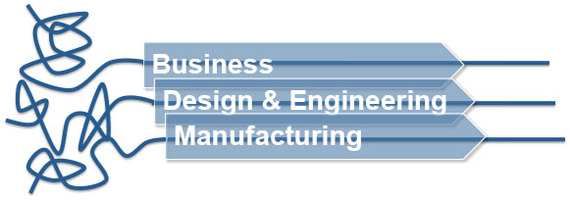With its artifacts, participants and processes, New Product Development has undergone a revolution in the past twenty years. Global connectivity, distribution, digital tools and rapid prototyping have increased development speed while reducing the cost of turning ideas into offerings to get the most bang for our buck.
With all this change in detail and dynamic complexity, more than ever, the quality of the outcome depends on the integrated collaboration between business, design and engineering. This integration, in and of itself, can be a powerful competitive advantage that is impossible to imitate if managed well.
Teaching and practicing Integrated Design is far from a new idea. In the late '80's The Technical University of Denmark, The Royal Danish Academy and Copenhagen Business School jointly conducted corporate sponsored project courses, consisting of engineering, design and business students. Danish industry adapted the Integrated Product Development process leading to the Danish Design (The Danish Culture's Competitive Design Advantage) offerings we know today and, in the process has helped build "the happiest country in the world."
The world, at that time, was far less connected in time and space and environmental design thinking was limited to preventing manufacturing from polluting the local air and water. No one had yet thought of designing offerings with a cradle-to-cradle life cycle. Social concerns were uncommon and the only triple-bottom-line component actually being measured was profit.
Since then, New Product Development (NPD) has undergone a transformation. In the 1980s, NPD focused mainly on incremental to medium innovative product development. To consider design in a business context was still quite a new understanding and few were engaged in strategic design, breakthrough innovation or new entrepreneurial ventures. Now offerings are all about strategic entrepreneurial innovation and this is included in our methods.
In this rapidly changing world, Integrated Design needs to evolve as well. To do so, it needs to embrace New Entrepreneurial Ventures, Strategy and Breakthrough Innovations. Fortunately, recent advances in design science research offer Integrated Design new methods, processes and tools for addressing these key issues.
New Entrepreneurial Ventures require the design team to build an organization with the right capabilities while concurrently creating an offering. This means building a culture and an architectural structure together with acquiring the necessary resources so all is at the level needed within the development process.
The Design Driven Startup method (Predicting the Success of Design Driven Startups) guides entrepreneurs though the initial process of positioning their offering in a Market - Technology Risk Matrix, assessing their level of design quality and, thus, their execution risk. When market, technology and execution risk are multiplied, one has a good assessment of risk exposure and can then begin to mediate the venture's inherent risk by applying Design and Business Model Experimentation (Design and Business Model Creation) and a Design Balance Scorecard (Design Scorecard for Incremental & Breakthrough Innovation).
Having assessed the startups challenges, a strategy for navigating these challenges is essential. Strategy defines the objectives, goals and tactics of allocating resources, establishes a schedule and defines the deliverable. At this juncture, Design Driven Portfolio Management can assist in planning the path for R&D, business cases, platforms, products and their derivatives. The outcome of all of this becomes the requirements needed for an Inspirational Design Briefing, (Design Briefs' Quality Drive Design Performance) so that the design team can succeed in their objective.

